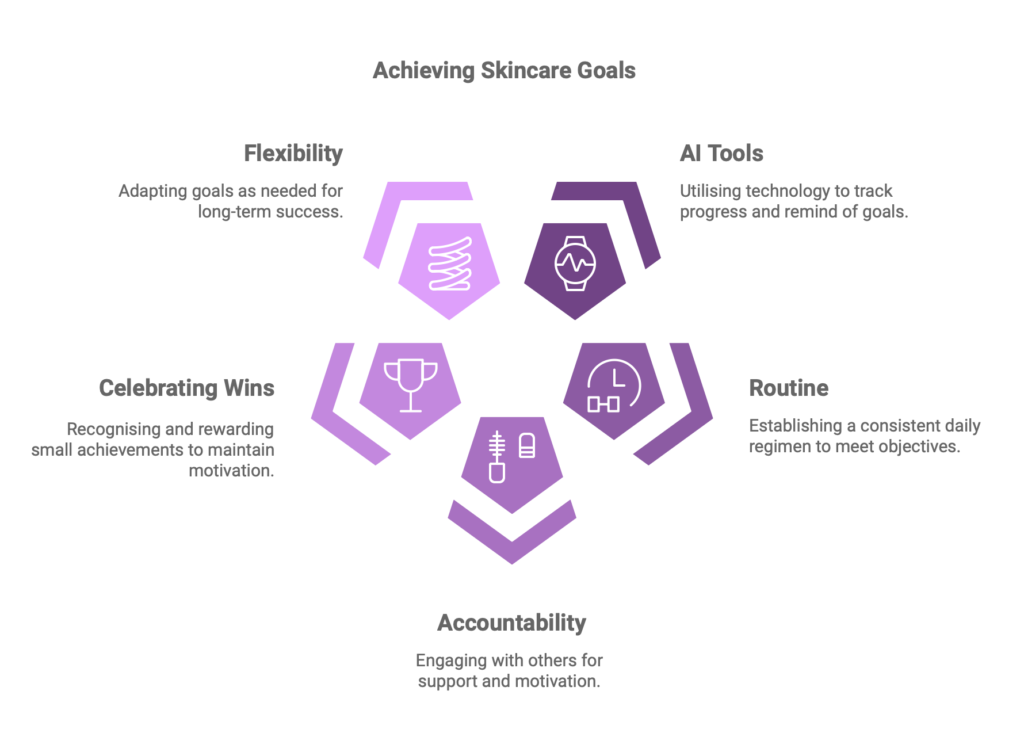
As 2025 approaches, many of us are gearing up to set personal goals for the new year. We often think about personal growth, health, relationships, and even financial aspirations. But how many of us take the time to set skin goals? Flawless skin is a universal desire, and studies have shown that skin conditions can significantly impact our personal and professional confidence. In fact, there’s even a field called psychodermatology that explores the connection between skin health and mental well-being.
To embrace the mantra of “Better Skin, Better You,” we need to take skincare seriously. By applying the CLEAR Skin Framework, we can systematically achieve our skin goals. With the help of AI-powered tools, we can accurately classify our skin types and learn about our skin needs. Now, it’s time to establish SMART skin goals that will guide us toward healthier, more radiant skin in 2025. Let’s dive in!
What is Skin Goal Setting?
Skin goal setting is the process of identifying specific, actionable objectives related to your skin health. Just like any other personal goal, setting skin goals helps you focus your efforts and track your progress. Whether you want to reduce acne, improve hydration, or achieve a more even skin tone, having clear goals can motivate you to take consistent action.
Why is it Important to Set Skin Goals?

- Enhances Focus: Setting specific goals helps you concentrate on what matters most for your skin.
- Boosts Confidence: Achieving skin goals can significantly improve your self-esteem and overall confidence.
- Encourages Consistency: Having clear objectives makes it easier to stick to a skincare routine.
- Provides Direction: Goals give you a roadmap for your skincare journey, helping you make informed decisions about products and treatments.
How to Set Skin Goals: A Step-by-Step Guide
Setting skin goals doesn’t have to be overwhelming. By following the SMART criteria—Specific, Measurable, Achievable, Realistic, and Timely—you can create effective goals that lead to real results. Here’s how to do it:
Step 1: Identify Your Primary and Secondary Goals
Start by choosing two skin goals: one primary and one secondary. This approach helps you focus your efforts without feeling overwhelmed.
Example Primary Goal: Reduce acne breakouts by 50% in three months.
Example Secondary Goal: Improve skin hydration levels to achieve a dewy complexion within two months.
Step 2: Make Your Goals SMART

Specific
- Primary Goal: “I want to reduce acne breakouts by 50%.”
- Secondary Goal: “I want to improve my skin hydration levels.”
Measurable
- Primary Goal: Track the number of breakouts weekly using a skincare journal or an app like TroveSkin.
- Secondary Goal: Measure hydration levels using a skin hydration meter or by observing changes in skin texture.
Achievable
- Primary Goal: Consult with a dermatologist to create a personalised treatment plan that includes topical treatments and lifestyle changes.
- Secondary Goal: Incorporate a hydrating serum and drink at least eight glasses of water daily.
Realistic
- Primary Goal: A 50% reduction in breakouts is realistic with consistent treatment and care.
- Secondary Goal: Improving hydration is achievable with the right products and habits.
Timely
- Primary Goal: Set a deadline of three months to see significant improvement.
- Secondary Goal: Aim for noticeable hydration improvements within two months.
Step 3: Create an Action Plan
Once you’ve established your SMART goals, outline the steps you’ll take to achieve them. For example:
For Reducing Acne:
- Consult a Dermatologist: Schedule an appointment to discuss treatment options.
- Implement a Skincare Routine: Use a gentle cleanser, targeted treatments, and non-comedogenic moisturisers.
- Track Progress: Use an app or journal to log breakouts and product usage.
For Improving Hydration:
- Choose the Right Products: Select a hydrating serum and moisturiser suitable for your skin type.
- Stay Hydrated: Set reminders to drink water throughout the day.
- Monitor Changes: Observe how your skin feels and looks over the next two months.
How to Stick with Your Goals and Achieve Them Consistently

Setting goals is just the beginning; sticking to them is where the real challenge lies. Here are some tips to help you stay on track:
- Use AI-Powered Tools: Apps like TroveSkin can help you track your progress and remind you of your goals.
- Create a Routine: Establish a daily skincare routine that incorporates your goals. Consistency is key!
- Stay Accountable: Share your goals with a friend or join a skincare community for support and motivation.
- Celebrate Small Wins: Acknowledge your progress, no matter how small. Celebrating milestones can keep you motivated.
- Adjust as Needed: If you find that a goal is too ambitious or not working, don’t hesitate to adjust it. Flexibility is essential for long-term success.
Approaching glowing 2025
As we approach 2025, it’s the perfect time to prioritise your skin health by setting clear, actionable skin goals. By applying the SMART criteria and utilising AI-powered tools, you can create a roadmap for achieving healthier, more radiant skin. Remember, flawless skin is not just about appearance; it’s about boosting your confidence and enhancing your overall well-being.
Let’s make 2025 the year of skin health! Embrace the journey, stay committed to your goals, and watch as your skin transforms. You’ve got this, and I’m here cheering you on every step of the way!
Frequently Asked Questions
What exactly are skin goals, and why should I bother setting them for 2025?
Skin goals are specific, actionable objectives related to your skin health that help you focus on improving your skin’s condition. They’re important because they provide direction, enhance consistency in your skincare routine, and boost confidence. By setting clear goals using the SMART framework, you create a structured approach to addressing skin concerns like acne, hydration, or uneven skin tone. Ultimately, skin goals are about more than just appearance—they’re a pathway to better self-care and improved mental well-being.
How do I create SMART skin goals that I can actually achieve?
Creating SMART skin goals involves being Specific, Measurable, Achievable, Realistic, and Timely. Start by identifying one primary and one secondary skin concern. For example, a primary goal might be “Reduce acne breakouts by 50% in three months” and a secondary goal could be “Improve skin hydration.” Use tools like skincare tracking apps, consult with dermatologists, and set clear metrics to measure progress. Most importantly, ensure your goals are realistic and align with your skin type and lifestyle.
Can AI-powered tools really help me track and achieve my skin goals?
AI-powered skincare tools like TroveSkin can be incredibly helpful in tracking your skin goals. These tools use advanced algorithms to monitor changes in your skin, provide personalised insights, and help you stay accountable. They can track breakouts, hydration levels, and overall skin improvements, offering objective measurements and reminders. While they’re not a complete replacement for professional advice, they provide valuable support in your skincare journey by offering data-driven insights and helping you maintain consistency.
What’s the connection between skin health and mental well-being?
The field of psychodermatology explores the intricate relationship between skin health and mental well-being. Skin conditions can significantly impact personal and professional confidence, creating a cycle of emotional stress. By setting and achieving skin goals, you’re not just improving your physical appearance, but also boosting self-esteem and reducing anxiety. Addressing skin concerns systematically can lead to improved mental health, increased confidence, and a more positive self-image.
How often should I reassess my skin goals?
It’s recommended to reassess your skin goals every 2-3 months. This timeframe allows you to see meaningful progress while providing flexibility to adjust your approach. Use AI-powered tracking tools or a skincare journal to monitor changes, and don’t be afraid to modify your goals if they’re not working. The key is to remain flexible and responsive to your skin’s changing needs. Celebrate small wins along the way, and remember that consistent effort is more important than perfection.
What are the most common mistakes people make when setting skin goals?
Common mistakes include setting unrealistic expectations, trying to address too many concerns at once, and lacking a structured approach. Many people create vague goals like “get better skin” without specific metrics. Others jump between products without giving them time to work or fail to consider their unique skin type. The most critical errors are inconsistency, not seeking professional advice when needed, and becoming discouraged by slow progress. The SMART goal framework helps avoid these pitfalls by providing a clear, achievable roadmap.
How can I stay motivated and consistent with my skin goals?
Staying motivated requires a multi-faceted approach. Create a daily skincare routine that supports your goals, use AI-powered tracking tools to monitor progress, and share your journey with a supportive community. Celebrate small victories, take progress photos, and be patient with yourself. Consider using accountability methods like joining online skincare groups or working with a skincare professional. Remember that consistency is key, and minor setbacks are normal. Your skin is a journey, not a destination.






